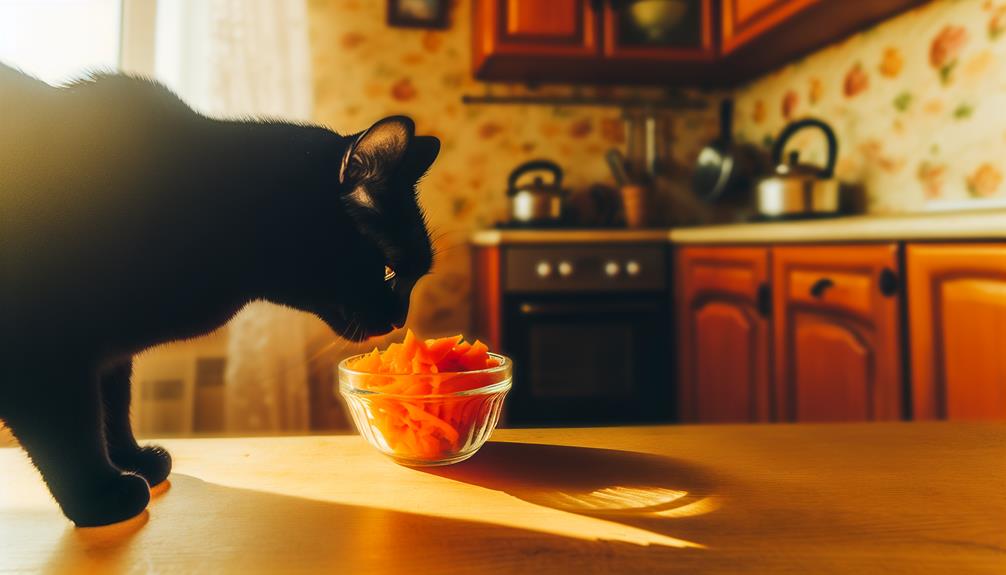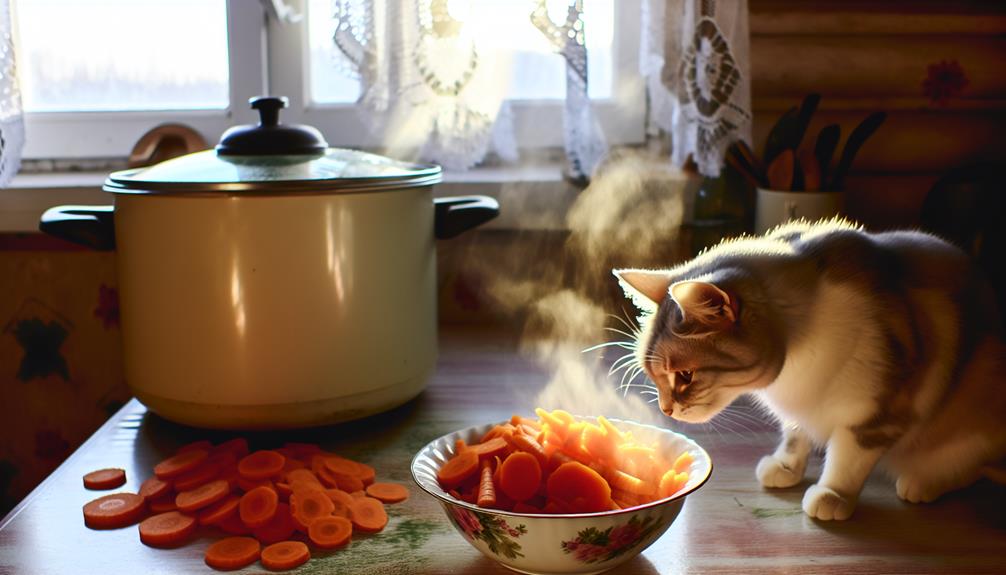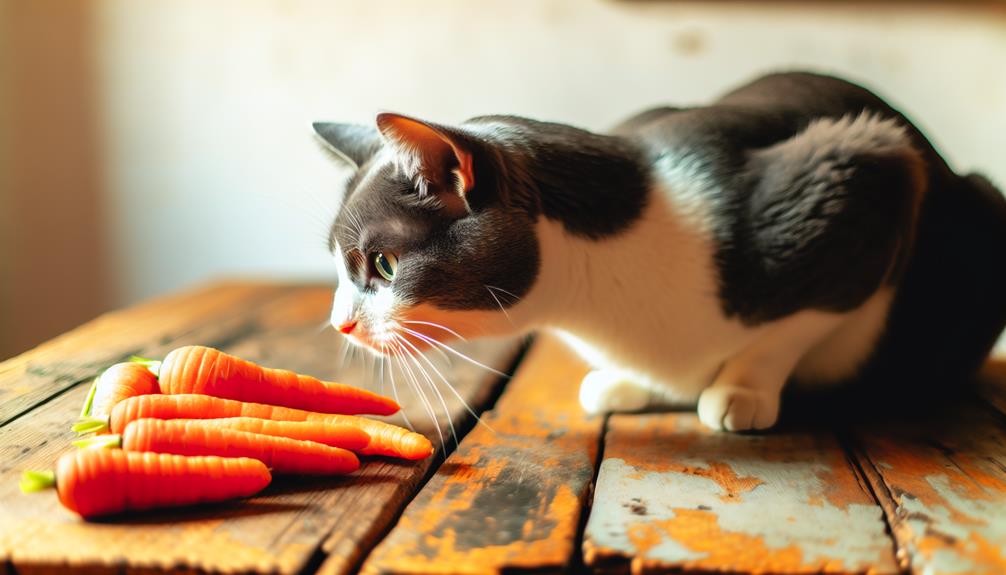You might think carrots are off the menu for cats, but they can actually eat them in moderation. While primarily carnivorous, cats can benefit from the essential vitamins and minerals found in carrots, like beta-carotene for vision and immune support. However, it's important to remember that carrots should only be an occasional treat. So, how do you introduce carrots safely into your cat's diet, and what are the potential risks you need to take into account? Let's explore these questions further to guarantee your feline friend stays healthy and happy.
Nutritional Benefits of Carrots
When it comes to the nutritional benefits of carrots, you'll find that these root vegetables pack a punch. Carrots, whether they're the common orange variety or the vibrant purple and yellow ones, are nutritional powerhouses. Rich in beta-carotene, which converts to vitamin A in the body, they play an essential role in maintaining healthy vision, immune function, and skin health.
You'll also appreciate that carrots are low in calories, making them an excellent choice for weight management. They contain dietary fiber, which aids in digestion and promotes a healthy gut microbiome. This can be particularly beneficial for your pets, as a well-functioning digestive system is fundamental for overall health.
Carrot varieties don't just differ in color; they also vary in their nutrient profiles. For instance, purple carrots are rich in anthocyanins, potent antioxidants that can help reduce inflammation. Yellow carrots contain lutein, which supports eye health. Despite these differences, all carrot varieties share common health benefits that make them a fantastic addition to a balanced diet.
Carrots are also a good source of several essential vitamins and minerals, including vitamin K, potassium, and vitamin C. Vitamin K is crucial for blood clotting and bone health, while potassium helps regulate fluid balance, muscle contractions, and nerve signals. Vitamin C, an antioxidant, supports the immune system and aids in the maintenance of healthy skin.
Carrots in a Cat's Diet
Incorporating carrots into your cat's diet can offer nutritional benefits, such as vitamins and fiber, but it's essential to prepare and serve them properly. You should always cook carrots to soften them, making them easier for your cat to digest. Be aware of potential risks like choking hazards and digestive upset, which underscores the importance of moderation and careful preparation.
Nutritional Benefits
Cats can indeed nibble on carrots, and these vibrant orange vegetables pack a punch of nutritional benefits for your feline friend. Carrots are rich in essential vitamins and minerals that can enhance feline nutrition without posing significant risks. One of the primary carrot benefits is their high beta-carotene content, which converts to vitamin A—a nutrient essential for maintaining healthy vision, immune function, and skin health in cats.
Incorporating carrots into your cat's diet can introduce valuable fiber, aiding digestion, and promoting a healthy gut. Additionally, carrots contain antioxidants that help combat free radicals, potentially reducing the risk of chronic diseases.
Here are some key nutritional benefits of carrots for cats:
- Beta-Carotene: Essential for converting to vitamin A, supporting vision and immune health.
- Fiber: Helps maintain digestive health and prevent constipation.
- Antioxidants: Protects against oxidative stress and supports overall well-being.
- Potassium: important for proper muscle function and electrolyte balance.
- Low Calories: Offers a healthy, low-calorie treat option for weight management.
While carrots can be a nutritious supplement, they should not replace a balanced feline diet. Always consult your veterinarian before making any dietary changes to guarantee your cat's nutritional needs are fully met.
Preparation and Serving
Preparing and serving carrots to your cat requires careful consideration to maximize their benefits while ensuring safety. First, you should always cook the carrots, as raw carrots can be too hard and pose a choking hazard. Steaming is one of the preferred cooking methods because it softens the carrots while preserving most of their nutrients. Boiling is another option but can lead to nutrient loss.
When preparing the carrots, cut them into small, bite-sized pieces that are easy for your cat to consume. Cats have different preferences, so you might need to experiment with the texture. Some cats may enjoy mashed carrots, while others might prefer them finely chopped or pureed.
Moreover, avoid adding any seasonings, oils, or butter, as these can be harmful to your cat. Plain, cooked carrots are the safest option. Introduce them gradually to observe how your cat reacts. Start with a small amount mixed into their regular food to see if they show any interest or adverse reactions.
Potential Risks
While cooked carrots can be a nutritious addition to your cat's diet, it's important to be aware of the potential risks associated with feeding them to your feline friend. Although carrots are not inherently toxic to cats, improper preparation or excessive consumption can lead to issues.
First, carrot toxicity is not a major concern, but some cats may exhibit allergic reactions. Symptoms might include itching, swelling, or respiratory distress. Additionally, carrots are high in fiber, which can be beneficial in moderation but may cause digestive upset if consumed in large quantities. This could result in diarrhea or constipation.
Moreover, raw carrots pose a choking hazard due to their firm texture. Always guarantee carrots are cooked and cut into small, manageable pieces. Finally, carrots contain natural sugars that, if fed in excess, could contribute to weight gain or interfere with your cat's balanced diet.
To summarize, be mindful of these potential risks:
- Allergic reactions: Watch for signs like itching and swelling.
- Digestive upset: High fiber content can cause diarrhea or constipation.
- Choking hazard: Raw carrots are hard to chew.
- Excessive sugars: Contributes to weight gain.
- Balanced diet: Guarantee carrots don't replace essential nutrients.
Digestive Considerations

When considering the digestive system of felines, it is crucial to understand how their bodies process different types of food. Cats, as obligate carnivores, have evolved to primarily digest meat, meaning their digestive enzymes are optimized for breaking down proteins and fats, rather than carbohydrates and plant matter. This fundamental difference in their digestive physiology can influence how they handle foods like carrots.
Carrots are rich in fiber content, which can be beneficial for digestion in moderate amounts. However, cats don't produce significant amounts of amylase, the enzyme responsible for breaking down plant-based carbohydrates. This absence makes it more challenging for them to efficiently process high-fiber vegetables. While fiber can aid in regulating a cat's bowel movements and prevent constipation, too much fiber can lead to gastrointestinal disturbances, such as diarrhea or gas.
Moreover, the fiber in carrots isn't as easily digestible due to the feline digestive system's limited ability to ferment plant material. Unlike herbivores, cats have a shorter digestive tract, which restricts the time available for breaking down fibrous substances. This means that while small quantities of carrots might pass through their system without causing harm, larger amounts could potentially lead to digestive inefficiencies or discomfort.
Potential Risks and Precautions
Feeding your cat carrots comes with potential risks that you should be aware of to guarantee your pet's health. While carrots are generally non-toxic to cats, there are several considerations to keep in mind to avoid adverse effects. Cat owners should be particularly vigilant about toxicity concerns, as even seemingly harmless vegetables can pose risks if not properly managed.
First, be aware of allergic reactions. Just like humans, cats can develop allergies to certain foods, including carrots. Symptoms of food allergies in cats may include itching, swelling, or gastrointestinal upset. If you observe any of these signs, discontinue feeding carrots immediately and consult your veterinarian.
Second, overconsumption of carrots can lead to digestive issues. Although carrots are a good source of fiber, too much fiber can result in diarrhea or constipation in cats. Moderation is key to ensuring that your cat reaps the benefits without suffering from digestive disturbances.
Here are some additional precautions to take:
- Choking Hazards: Carrots should be appropriately sized to prevent choking, especially for smaller cats.
- Pesticide Residues: Always wash carrots thoroughly to remove any harmful pesticides or chemicals that could affect your cat's health.
- High Sugar Content: Carrots contain natural sugars that could contribute to weight gain or diabetes if consumed excessively.
- Nutritional Imbalance: Relying too heavily on carrots can lead to an imbalanced diet. Cats need a diet rich in animal proteins.
- Veterinary Advice: Always consult your vet before introducing any new food, including carrots, into your cat's diet.
How to Serve Carrots

When serving carrots to your cat, it's essential to prepare them safely by cooking until soft and cutting into small, manageable pieces. Limit portions to occasional small treats, ensuring they don't exceed 10% of your cat's diet. Frequency should be sparing, such as once or twice a week, to prevent any nutritional imbalances.
Preparing Carrots Safely
Guaranteeing your cat can safely enjoy carrots involves a few critical preparation steps. First, consider the cooking methods. While raw carrots are safe, they can be hard for cats to chew and digest. Cooking them, whether by steaming or boiling, softens the texture and makes them easier to consume. Avoid any seasoning or additives, as these can be harmful to your feline friend.
Next, consider the types of carrots. Organic carrots are preferable because they're free from pesticides and other harmful chemicals. Baby carrots are also an excellent option due to their convenient size, though regular carrots can be chopped into smaller pieces.
To guarantee your cat's safety and enjoyment, follow these guidelines:
- Wash Thoroughly: Clean the carrots to remove any dirt or chemical residues.
- Peel the Carrots: This removes the outer layer which might contain pesticides.
- Cook Until Soft: Steam or boil the carrots until they're tender.
- Cut into Small Pieces: Guarantee they're bite-sized to prevent choking.
- Cool Before Serving: Make sure the carrots are at room temperature to avoid burns.
Appropriate Portion Sizes
Determining the appropriate portion sizes for serving carrots to your cat is essential for maintaining their health. Cats are obligate carnivores, meaning their primary nutritional needs are met through meat. Consequently, any addition of vegetables like carrots should be treated as a minor supplement rather than a staple of their diet.
For effective portion control, consider offering no more than one to two teaspoon-sized servings of finely diced or pureed carrots. This guarantees that your cat receives the nutritional benefits without overloading their system with unnecessary carbohydrates and fibers, which are harder for them to digest. Too much carrot can lead to gastrointestinal disturbances, including diarrhea and gas.
When it comes to serving suggestions, always introduce carrots in small amounts to monitor for any adverse reactions. Carrots should be cooked—steamed or boiled without any seasoning—to make them easier for your cat to chew and digest. Avoid raw carrots, as they can pose choking hazards and are difficult for cats to break down.
Serving Frequency Guidelines
Introducing carrots into your cat's diet should be done with careful consideration of serving frequency. While carrots can offer nutritional benefits, moderation is key to maintaining peak cat health. Typically, serving carrots once or twice a week is sufficient. Overfeeding can lead to digestive issues, as cats' digestive systems are not designed to handle large amounts of plant material.
When introducing carrots, consider the different carrot varieties and their preparation. Raw carrots can be hard for cats to chew and digest, so steaming or boiling them until they're soft can be more suitable. Always avoid adding seasoning or oils, as these can be harmful to your cat.
Here are some guidelines to help you serve carrots to your cat responsibly:
- Frequency: Serve carrots no more than 1-2 times a week.
- Preparation: Steam or boil carrots until soft, avoiding any seasonings.
- Portion Size: Keep portions small, around one to two bite-sized pieces.
- Observation: Monitor your cat for any adverse reactions after introducing carrots.
- Variety: Occasionally switch between different carrot varieties for a range of nutrients.
Alternative Veggies for Cats
When considering dietary diversity for your feline friend, it's vital to explore a variety of vegetables that can safely complement their primarily carnivorous nature. While cats don't need vegetables to meet their nutritional requirements, some vegetable varieties can provide supplementary vitamins, minerals, and fiber. It's important to identify which veggies align with cat preferences and dietary tolerances.
Certain vegetables can be beneficial when offered in moderation. For instance, green beans are low in calories and high in fiber, which can aid in digestion. Peas are another option, providing vitamins A and C, along with antioxidants. However, it's important to avoid vegetables that are toxic to cats, such as onions and garlic.
Here's a quick reference table to help you select suitable veggies for your cat:
| Vegetable | Nutritional Benefit | Serving Tip |
|---|---|---|
| Green Beans | High in fiber | Steam and chop into small pieces |
| Peas | Rich in vitamins A and C | Offer fresh or lightly cooked |
| Zucchini | Low-calorie, high in water | Slice thinly or grate |
| Pumpkin | High in fiber, aids digestion | Use cooked, mashed form |
| Spinach | Packed with vitamins and iron | Serve cooked, in small quantities |
Always introduce new vegetables slowly and observe your cat for any adverse reactions. Remember, veggies should not replace their main diet but serve as occasional treats. The key is to confirm that any dietary additions are safe and enhance your cat's overall well-being without compromising their nutritional balance. Consulting with a veterinarian before making significant changes to your cat's diet is always advisable.
Conclusion
In summary, while cats can enjoy carrots as an occasional treat, they shouldn't replace their primary diet. Carrots provide valuable nutrients, but remember, moderation is key. Always consult your veterinarian before introducing new foods. Think of carrots as a garnish, not the main course, for your feline's nutrition. By doing so, you'll guarantee your cat's health remains in tip-top shape while adding a bit of variety to their diet.
